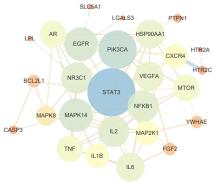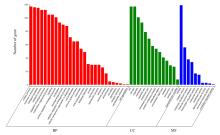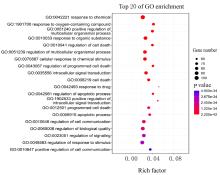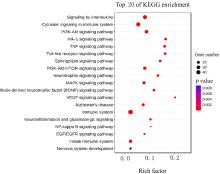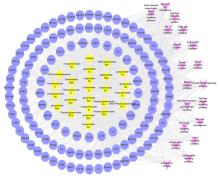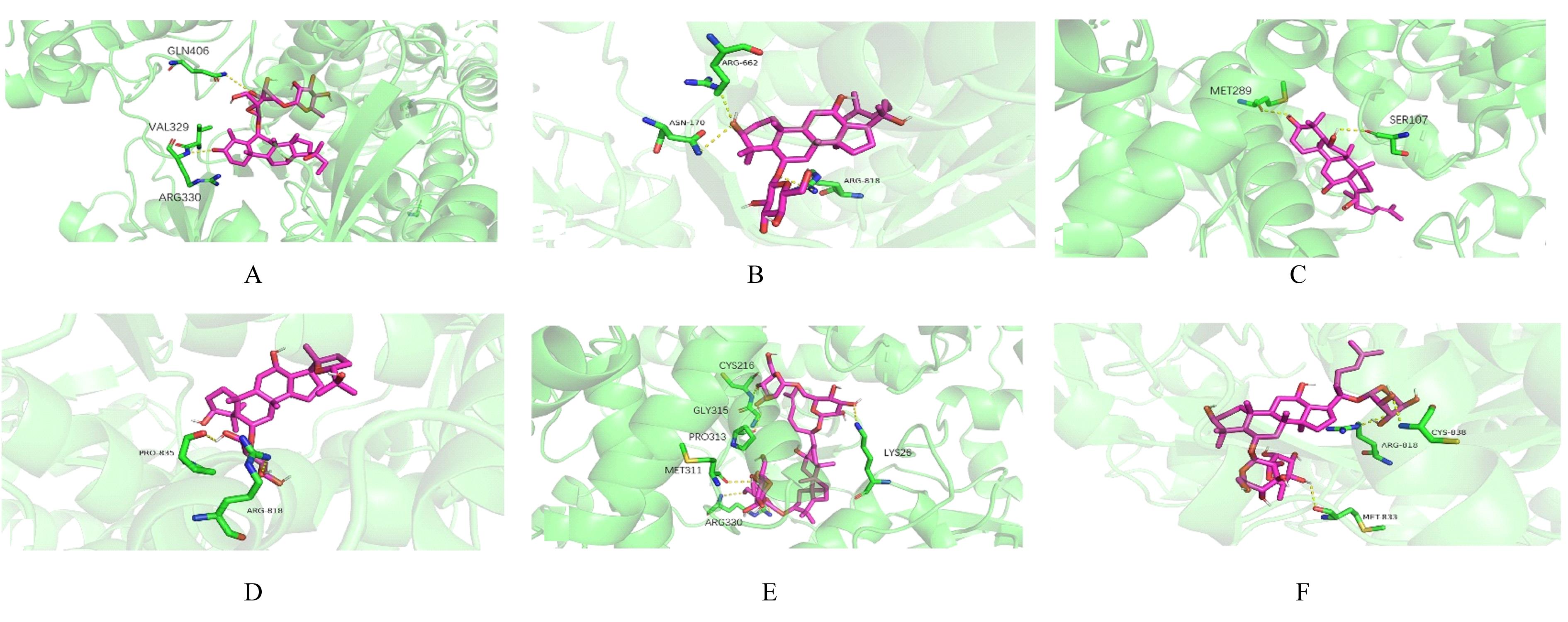Journal of Jilin University(Medicine Edition) ›› 2023, Vol. 49 ›› Issue (4): 913-922.doi: 10.13481/j.1671-587X.20230412
• Research in basic medicine • Previous Articles Next Articles
Network pharmacology and molecular docking analysis on anti-ischemic stroke mechanism of Panax quinquefolium triolsaponins
Sihan LAI,Juntong LIU,Luying TAN,Jinping LIU( ),Pingya LI(
),Pingya LI( )
)
- Research Center of Natural Drug,School of Pharmaceutical Sciences,Jilin University,Changchun 130021,China
-
Received:2022-10-22Online:2023-07-28Published:2023-07-26 -
Contact:Jinping LIU,Pingya LI E-mail:liujp@jlu.edu.cn;lipy@jlu.edu.cn
CLC Number:
- R285.5
Cite this article
Sihan LAI,Juntong LIU,Luying TAN,Jinping LIU,Pingya LI. Network pharmacology and molecular docking analysis on anti-ischemic stroke mechanism of Panax quinquefolium triolsaponins[J].Journal of Jilin University(Medicine Edition), 2023, 49(4): 913-922.
share this article
Tab. 1
UPLC-Q-TOF-MS identification results of chemical compositions of PQTS"
| Number | Chemical composition | CAS |
|---|---|---|
| 1 | Yesanchinoside B | 416843-85-1 |
| 2 | Quinquenoside L9 | 412328-82-6 |
| 3 | Yesanchinoside C | 416843-86-2 |
| 4 | Quinquenoside F6 | 1255210-79-7 |
| 5 | Yesanchinoside E | 416843-87-3 |
| 6 | (24S)-Pseudo-ginsenoside F11 | 102805-33-4 |
| 7 | Ginsenoside Rg1 | 22427-39-0 |
| 8 | Ginsenoside Re | 52286-59-6 |
| 9 | Ginsenoside Rb1 | 41753-43-9 |
| 10 | Majoroside F5 | 125309-99-1 |
| 11 | Ginsenoside F1 | 53963-43-2 |
| 12 | Vinaginsenoside R1 | 156980-41-5 |
| 13 | (20R)-Dammar-20, 25-epoxy-3β, 6α, 7β, 12β, 15α-pentaol | - |
| 14 | Pseudo-ginsenoside F11 | 69884-00-0 |
| 15 | Pseudo-ginsenoside RT4 | 98474-77-2 |
| 16 | Pseudo-ginsenoside RT5 | 98474-78-3 |
| 17 | Ginsenoside A | 193895-21-5 |
| 18 | Ginsenoside F5 | 189513-26-6 |
| 19 | Dammar-3β,6α,12β,20R,25-pentaol | - |
| 20 | Ginsenoside Rg2 | 52286-74-5 |
| 21 | Ocotillol | 5986-39-0 |
| 22 | Ginsenoside F3 | 62025-50-7 |
| 23 | Ginsenoside Rh1 | 80952-71-2 |
| 24 | Vinaginsenoside R2 | 156980-42-6 |
| 25 | Notopanaxoside A | 920265-99-2 |
| 26 | Ginsenoside Rh4 | 174721-08-5 |
| 27 | 20(R)-ginsenoside Rh1 | 63223-86-9 |
| 28 | Ginsenoside F4 | 126223-28-7 |
| 29 | Ginsenoside Rg8 | 906089-57-4 |
| 30 | 20(S)-protopanaxatriol | 34080-08-5 |
| 31 | Ginsenoside Rg6 | 147419-93-0 |
| “-”:No data. | ||
Tab. 2
Degree values of chemical compositions of PQTS"
| Chemical composition | Degree value | Chemical composition | Degree value |
|---|---|---|---|
| Pseudo-ginsenoside F11 | 43 | Ginsenoside F4 | 21 |
| 20(S)-protopanaxatriol | 38 | Vinaginsenoside R2 | 20 |
| Ginsenoside Rg1 | 35 | Ginsenoside Rg2 | 17 |
| Ginsenoside Rh1 | 29 | Yesanchinoside B | 17 |
| Vinaginsenoside R1 | 28 | Yesanchinoside C | 17 |
| Ginsenoside Rb1 | 26 | Ginsenoside A | 16 |
| 20(R)-ginsenoside Rh1 | 25 | Notopanaxoside A | 13 |
| (24S)-Pseudo-ginsenoside F11 | 25 | Ocotillol | 12 |
| Ginsenoside Rh4 | 25 | Ginsenoside Rg6 | 10 |
| Ginsenoside Re | 24 | Yesanchinoside E | 10 |
| Pseudo-ginsenoside RT4 | 23 | Ginsenoside F3 | 9 |
| Pseudo-ginsenoside RT5 | 23 | Ginsenoside F5 | 8 |
| Ginsenoside F1 | 21 | Majoroside F5 | 3 |
Tab. 3
Binding energy of molecular docking and binding sites of main active compositions and core targets of PQTS"
| Ligand | STAT3 | PIK3CA | EGFR | MAPK14 | |||||
|---|---|---|---|---|---|---|---|---|---|
Affinity (kJ?mol-1) | Binding site | Affinity (kJ?mol-1) | Binding site | Affinity (kJ?mol-1) | Binding site | Affinity (kJ?mol-1) | Binding site | ||
| PF11 | -9.7 | GLY70 ASP71 ARG57 | -10.7 | GLN406 VAL329 ARG330 | -9.0 | ALA80 ASP79 | -10.7 | ASP49 ARG30 ILE28 ILE27 GLN125 | |
| PPT | -7.5 | SER13 ASN58 | -9.8 | MET289 SER107 | -6.0 | ASP22 TYR23 | -8.2 | ASP49 GLY51 FEU52 | |
| Rg1 | -8.7 | GLY22 HIS23 ASP53 ASF71 ASN58 PRO10 ARG57 LEU19 | -10.4 | CYS216 GLY315 PRO313 MET311 ARG330 LYS26 | -8.4 | LYS46 GLY97 CYS98 ARG142 | -8.4 | GLU68 SER53 THR65 ARG64 ASP49 HIS29 ARG30 GLN125 | |
| Rh1 | -6.8 | GLY253 GLY254 | -9.0 | ARG662 ASN170 ARG818 | -8.5 | ILE953 ASP956 ALA755 GLU758 | -8.3 | ARG23 GLU22 | |
| PRT5 | -6.6 | ILE258 GLU324 ASP334 SER514 GLY253 | -9.4 | PRO836 ARG818 | -8.0 | CYS797 ARG841 ASN842 ASP855 LEU718 SER720 GLY721 | -7.4 | LYS152 SER154 ASP168 GLY110 MET109 | |
| Re | -7.2 | PRO333 ALA250 GLN247 ASN400 SER399 | -9.7 | MET833 ARG818 CYS838 | -7.8 | CYS797 SER720 ARG841 | -7.8 | GLU4 GLN3 VAL345 THR91 | |
| 1 | 朱 帅, 张一英, 向 芳, 等. 脑卒中高危人群缺血性脑卒中3年发病影响因素COX回归分析[J]. 中国慢性病预防与控制, 2022, 30(2): 134-137. |
| 2 | 张君琴, 张国新, 张振涛. 急性缺血性脑卒中后认知障碍的危险因素分析[J]. 中风与神经疾病杂志, 2021,38(1): 32-35. |
| 3 | 周啸天, 骆亚莉, 李佳蔚, 等. 补阳还五汤防治缺血性脑卒中作用机制的研究现状[J]. 中国临床药理学杂志, 2022, 38(9):1011-1015 |
| 4 | XIONG H, ZHANG A H, ZHAO Q Q, et al. Discovery of quality-marker ingredients of Panax quinquefolius driven by high-throughput chinmedomics approach[J]. Phytomedicine, 2020, 74: 152928. |
| 5 | LI L, WANG Y, XIU Y, et al. Chemical differentiation and quantitative analysis of different types of panax genus stem-leaf based on a UPLC-Q-exactive orbitrap/MS combined with multivariate statistical analysis approach[J].J Anal Methods Chem,2018,2018:9598672. |
| 6 | 李 伟, 王 莹, 刘 伟. 人参、西洋参非药用部位开发与利用研究进展[J].吉林农业大学学报, 2021, 43(4): 383-392. |
| 7 | 崔德深, 高镇生. 西洋参[M]. 北京: 科学出版社, 1984. |
| 8 | 王爱华, 王丽丽, 刘英梅, 等. 西洋参茎叶总皂苷对大鼠局灶性脑缺血损伤及其炎症反应的影响[J]. 中南药学, 2019, 17(4): 522-526. |
| 9 | 刘 松, 金梅香, 谭兴文. 西洋参茎叶皂苷保护大鼠脑缺血再灌注损伤的作用[J]. 中成药, 2016, 38(2): 418-421. |
| 10 | 曲绍春, 于晓风, 刘 巍, 等. 西洋参茎叶20s-原人参二醇组皂苷对大鼠实验性脑缺血的影响[J]. 中国中药杂志, 2011, 36(12): 1675-1678. |
| 11 | LI J, LUO H H, WANG X F, et al. Exploring the active ingredients and mechanism of qianglidingxuan tablets for vertigo based on network pharmacology and molecular docking[J]. Inform Med Unlocked, 2022, 29: 100877. |
| 12 | HOPKINS A L. Network pharmacology[J]. Nat Biotechnol, 2007, 25(10): 1110-1111. |
| 13 | 周昊言, 孙若岚, 季千惠, 等. 基于网络药理-分子对接解析川芎-赤芍药对干预脑缺血的作用机制[J]. 中国中药杂志, 2021, 46(12): 3007-3015. |
| 14 | LI F J, HATANO T, HATTORI N. Systematic analysis of the molecular mechanisms mediated by coffee in Parkinson’s disease based on network pharmacology approach[J]. J Funct Foods, 2021, 87: 104764. |
| 15 | YU J W, WANG L, BAO L D. Exploring the active compounds of traditional Mongolian medicine in intervention of novel coronavirus (COVID-19) based on molecular docking method[J]. J Funct Foods, 2020, 71: 104016. |
| 16 | DAINA A, MICHIELIN O, ZOETE V. SwissTargetPrediction: updated data and new features for efficient prediction of protein targets of small molecules[J]. Nucleic Acids Res,2019,47(W1): W357-W364. |
| 17 | VON MERING C, HUYNEN M, JAEGGI D, et al. STRING: a database of predicted functional associations between proteins[J]. Nucleic Acids Res, 2003, 31(1): 258-261. |
| 18 | 史大臻, 赖思含, 刘俊彤, 等. UPLC-Q/TOF-MS结合UNIFI库快速分析西洋参茎叶三醇皂苷[J]. 特产研究, 2021, 43(4)72-81 |
| 19 | YU Z Y, WU Y L, MA Y J, et al. Systematic analysis of the mechanism of aged citrus peel (Chenpi) in oral squamous cell carcinoma treatment via network pharmacology, molecular docking and experimental validation[J]. J Funct Foods, 2022, 91: 105012. |
| 20 | 曹 姗, 宋文婷, 徐 立, 等. 缺血性脑卒中的氧化/亚硝化应激和神经炎症反应与中西药治疗研究进展[J]. 世界科学技术-中医药现代化, 2021, 23(12):4647-4653 |
| 21 | LI J H, CHEN Z X, ZHANG X G, et al. Bioactive components of Chinese herbal medicine enhance endogenous neurogenesis in animal models of ischemic stroke: a systematic analysis[J]. Medicine (Baltimore), 2016, 95(40): e4904. |
| 22 | YI J H, PARK S W, KAPADIA R, et al. Role of transcription factors in mediating post-ischemic cerebral inflammation and brain damage[J]. Neurochem Int, 2007, 50(7/8): 1014-1027. |
| 23 | 方舒东, 朱也森, 姜 虹, 等. 大鼠短暂性全脑缺血后STAT3表达与神经元凋亡的关系[J]. 上海交通大学学报(医学版), 2007, 27(2): 193-196. |
| 24 | YU L, LIU Z L, HE W D, et al. Hydroxysafflor yellow A confers neuroprotection from focal cerebral ischemia by modulating the crosstalk between JAK2/STAT3 and SOCS3 signaling pathways[J]. Cell Mol Neurobiol, 2020, 40(8): 1271-1281. |
| 25 | LI L, SUN L L, QIU Y, et al. Protective effect of stachydrine against cerebral ischemia-reperfusion injury by reducing inflammation and apoptosis through P65 and JAK2/STAT3 signaling pathway[J]. Front Pharmacol, 2020, 11: 64. |
| 26 | ZHU H, JIAN Z H, ZHONG Y, et al. Janus kinase inhibition ameliorates ischemic stroke injury and neuroinflammation through reducing NLRP3 inflammasome activation via JAK2/STAT3 pathway inhibition[J]. Front Immunol, 2021, 12: 714943. |
| 27 | 吕明义, 邓淑玲, 郭文晏, 等. 木犀草素抑制JAK2/STAT3信号通路减轻大鼠脑缺血再灌注损伤作用的研究[J]. 天津医药, 2022, 50(4): 363-368. |
| 28 | 龚翠兰, 杨仁义, 周德生, 等. 基于miR-370-3p与JAK2/STAT3通路相关性探讨活血荣络方促缺血性脑卒中后血管新生的机制[J]. 中国药理学通报, 2022, 38(2): 297- 304. |
| 29 | CHEN D D, WEI L, LIU Z R, et al. Correction to: pyruvate kinase M2 increases angiogenesis, neurogenesis, and functional recovery mediated by upregulation of STAT3 and focal adhesion kinase activities after ischemic stroke in adult mice[J]. Neurotherapeutics, 2018, 15(3): 836. |
| 30 | 李 月. 基于JAK2/STAT3信号通路探讨复方当归注射液对缺血性脑卒中炎性反应的作用机制[D]. 北京: 北京中医药大学,2020. |
| 31 | SAMAKOVA A, GAZOVA A, SABOVA N, et al. The PI3k/Akt pathway is associated with angiogenesis, oxidative stress and survival of mesenchymal stem cells in pathophysiologic condition in ischemia[J]. Physiol Res, 2019, 68(): S131-S138. |
| 32 | ZHAO E Y, EFENDIZADE A, CAI L P, et al. The role of Akt (protein kinase B) and protein kinase C in ischemia-reperfusion injury[J].Neurol Res,2016,38(4): 301-308. |
| 33 | 张建云, 李婧雯, 张丽红, 等. PI3K/Akt信号通路与缺血性脑卒中的关系及中药干预的研究进展[J]. 中国实验方剂学杂志, 2022, 28(22): 265-275. |
| 34 | CHEN J M, ZHANG X J, LIU X X, et al. Ginsenoside Rg1 promotes cerebral angiogenesis via the PI3K/Akt/mTOR signaling pathway in ischemic mice[J]. Eur J Pharmacol, 2019, 856: 172418. |
| 35 | YUAN L L, SUN S B, PAN X H, et al. Pseudoginsenoside-F11 improves long-term neurological function and promotes neurogenesis after transient cerebral ischemia in mice[J]. Neurochem Int, 2020, 133: 104586. |
| [1] | Meng LIU,Xiaodong HUANG,Zheng HAN,Qingxi ZHU,Jie TAN,Xia TIAN. Effect of cadherin-17 on proliferation and apoptosis of colorectal cancer cells and its PI3K/AKT/mTOR signaling pathway regulatory mechanism [J]. Journal of Jilin University(Medicine Edition), 2023, 49(4): 1008-1017. |
| [2] | Li JIN,Xiaohong ZHANG,Chaoyang HU,Fengzhi LI,Yongliang CUI,Yang LI,Qianqian LIU,Yanjun QIAO. Effects of quercetin on growth and lung metastasis of transplanted tumor and cell invasion, and cell migration in human lung cancer A549 cells transplanted tumor model mice and their mechanisms [J]. Journal of Jilin University(Medicine Edition), 2023, 49(4): 1018-1026. |
| [3] | Xiangyu ZHANG,Yihong HU,Yucheng HAN,Xianqiong ZOU. Effect of ceramide 1-phosphate transfer protein on biological behavior of human oral squamous cell carcinoma HSC-3 cells [J]. Journal of Jilin University(Medicine Edition), 2023, 49(4): 875-883. |
| [4] | Zhaohui WAN,Liang ZENG,Jin LI,Changcheng LEI. Effect of PAX3 gene silencing on differentiation of P19 cells into cardiomyocyte-like cells and its mechanism [J]. Journal of Jilin University(Medicine Edition), 2023, 49(3): 647-655. |
| [5] | Yushuang GONG,Yefan FU,Huijing XU,Jian GUO,Lin XIANG,Rui HU,Rui FAN,Jie WANG,Miao LI,Meiyan SUN. Network pharmacology analysis on mechanism of Tonifying Slpeen and Kidney Empirical Prescription in treatment of neuromyelitis optica spectrum disorders [J]. Journal of Jilin University(Medicine Edition), 2023, 49(2): 261-271. |
| [6] | Yifei SUN,Dinuo LI,Yubin WANG. Inhibitory effect of curcumin on proliferation and invasion of gastric cancer MGC-803 cells by down-regulating PI3K/Akt/mTOR signaling pathway protein expression [J]. Journal of Jilin University(Medicine Edition), 2023, 49(2): 332-340. |
| [7] | Zhouquan LI,Hui LI,Ying TANG,Lijun YANG,Yinghong JIANG,Lipin YIN. Network pharmacology and molecular docking analysis on mechanism of Tongluo Tangtai Power in treatment of diabetic peripheral neuropathy [J]. Journal of Jilin University(Medicine Edition), 2023, 49(2): 341-350. |
| [8] | Minghui WANG,Moyi LIU,Helin WANG,Ying LI,Xiangjun WANG,Hetong HUI,Xinyuan FAN,Tianqi WANG,Limei LIU. Bioinformatics analysis of network pharmacology and molecular docking technology based on mechanism of Physalis Calyx seu Fructus on leukemia [J]. Journal of Jilin University(Medicine Edition), 2023, 49(1): 74-83. |
| [9] | Donghui LIU,Mingxi ZHANG,Wenliang FU,Xiumei FU,Chengjun SONG,Zhihong CHEN. Effects of sericin on injury of podocytes induced by high glucose and JNK signaling pathway [J]. Journal of Jilin University(Medicine Edition), 2022, 48(6): 1403-1410. |
| [10] | Heran YANG,Xingjiang LI,Jiahang HU,Yanwei LI. Effect of Ghrelin on neural differentiation of adipose-derived mesenchymal stem cells [J]. Journal of Jilin University(Medicine Edition), 2022, 48(6): 1490-1497. |
| [11] | Shaojie FU,Sensen SU,Yiying CHEN,Zhonggao XU. Analysis on network pharmacology and molecular docking technique based on mechanism of Shenqi Dihuang Decoction in treatment of membranous nephropathy [J]. Journal of Jilin University(Medicine Edition), 2022, 48(6): 1518-1527. |
| [12] | Hang YANG,Jiaqi CHEN,Shouhan WANG,Hongjun YANG,Bin WANG. Protective effect of ginsenoside Rg1 on cardiac injury in rats with severe acute pancreatitis and its mechanism [J]. Journal of Jilin University(Medicine Edition), 2022, 48(5): 1175-1181. |
| [13] | Hongxia SUN,Chunxu LIU,Xuejun AN,Guanghua CUI,Jingyu WANG,Shuangxi TONG,Xiaoqiu YANG. Effect of Schisandra chinensis polysaccharide on proliferation and apoptosis of human bladder cancer T24 cells and its mechanisms [J]. Journal of Jilin University(Medicine Edition), 2022, 48(5): 1216-1222. |
| [14] | Xiaomei HUANG,Hongwei WANG,Zhenyan HAN,Qiuyuan WEI,Sujing HUANG. Effects of lncRNA GHET1 on biological behaviors of trophoblast cells in preeclampsia through Wnt/β-catenin signaling pathway [J]. Journal of Jilin University(Medicine Edition), 2022, 48(5): 1324-1332. |
| [15] | Zhaohui WAN,Liang ZENG,Hui ZHOU,Jing LI,Changcheng LEI. Protective effect of polyphyllin Ⅶ on acute lung injury in rats with severe acute pancreatitis by inhibiting NF-κB signaling pathway [J]. Journal of Jilin University(Medicine Edition), 2022, 48(3): 668-675. |
|
||
